The ASRock DeskMini A300 Review: An Affordable DIY AMD Ryzen mini-PC
by Ganesh T S on April 26, 2019 8:00 AM ESTBAPCo SYSmark 2018
The ASRock DeskMini A300 was evaluated using our Fall 2018 test suite for small-form factor PCs. In the first section, we will be looking at SYSmark 2018.
Prior to describing the benchmark itself, we should quickly address concerns about using the benchmark to test AMD-based systems, given that AMD is not a part of the BAPCo consortium. In fact, AMD has been pretty vocal against the benchmark, with their last salvo appearing in 2016. AMD had quit BAPCo in 2011 over concerns of the GPU not being represented enough in the benchmarks.
Having analyzed the SYSmark 2018 white paper, and actually followed the execution of the benchmark workloads, we can say that SYSmark 2018 does represent possible usage patterns for a PC used in a business / office setting. Even if one were to side with AMD on the scoring aspect, the benchmark's rather unique energy consumption metric accurately represents the efficiency of the system for the realistic workloads. Overall, we believe that SYSmark 2018 is a good benchmark for systems used in certain scenarios; though it goes without saying that we never put too much stock in any one benchmark, which is why we only use it as one of out several benchmarks in our mini-PC reviews.
Anyhow, BAPCo's SYSmark 2018 is an application-based benchmark that uses real-world applications to replay usage patterns of business users in the areas of productivity, creativity, and responsiveness. The 'Productivity Scenario' covers office-centric activities including word processing, spreadsheet usage, financial analysis, software development, application installation, file compression, and e-mail management. The 'Creativity Scenario' represents media-centric activities such as digital photo processing, AI and ML for face recognition in photos and videos for the purpose of content creation, etc. The 'Responsiveness Scenario' evaluates the ability of the system to react in a quick manner to user inputs in areas such as application and file launches, web browsing, and multi-tasking.
Scores are meant to be compared against a reference desktop (the SYSmark 2018 calibration system, a Dell Optiplex 5050 tower with a Core i3-7100 and 4GB of DDR4-2133 memory to go with a 128GB M.2 SATA III SSD). The calibration system scores 1000 in each of the scenarios. A score of, say, 2000, would imply that the system under test is twice as fast as the reference system.
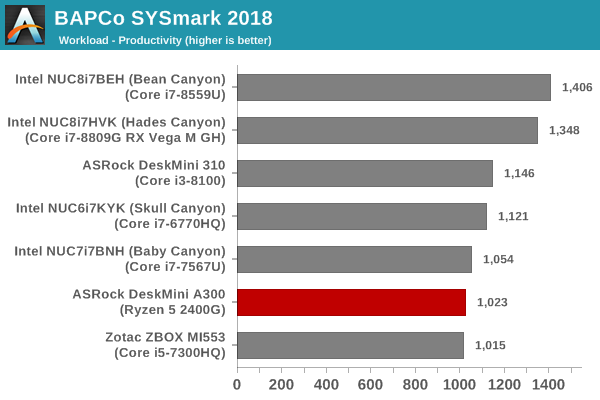
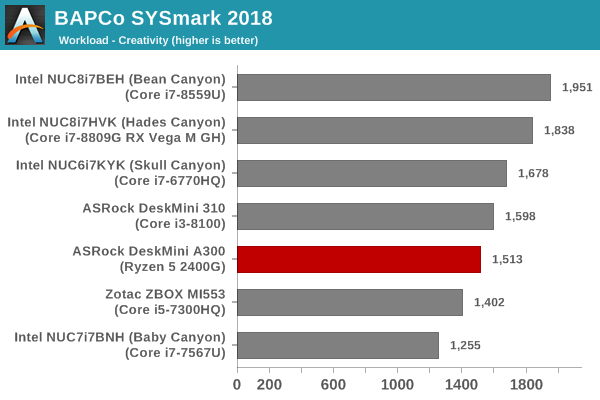
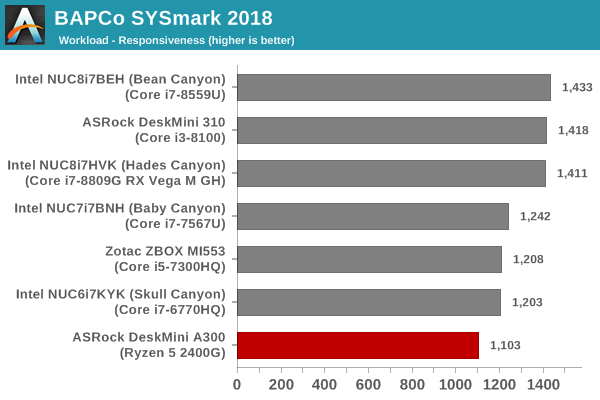
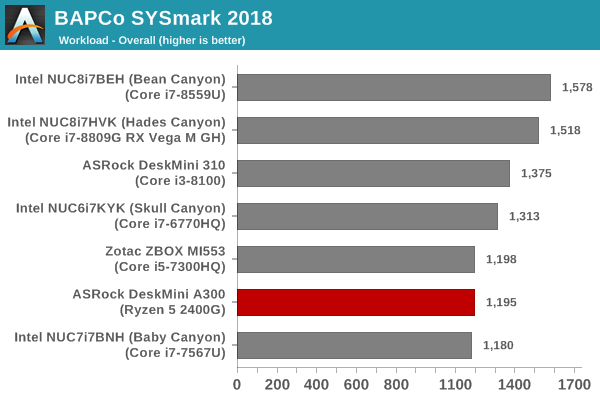
SYSmark 2018 also adds energy measurement to the mix. A high score in the SYSmark benchmarks might be nice to have, but, potential customers also need to determine the balance between power consumption and the efficiency of the system. For example, in the average office scenario, it might not be worth purchasing a noisy and power-hungry PC just because it ends up with a 2000 score in the SYSmark 2014 SE benchmarks. In order to provide a balanced perspective, SYSmark 2018 also allows vendors and decision makers to track the energy consumption during each workload. In the graphs below, we find the total energy consumed by the PC under test for a single iteration of each SYSmark 2018 workload. For reference, the calibration system consumes 5.36 Wh for productivity, 7.71 Wh for creativity, 5.61 Wh for responsiveness, and 18.68 Wh overall.
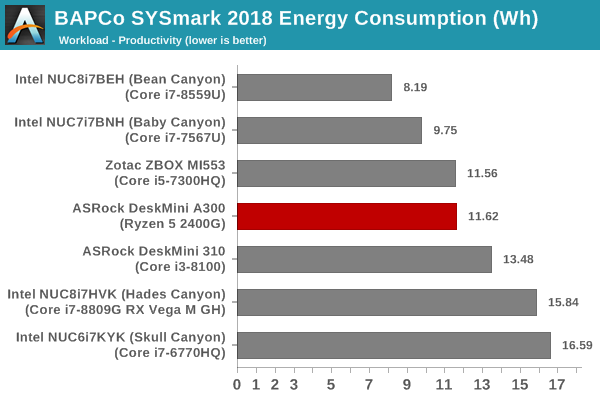


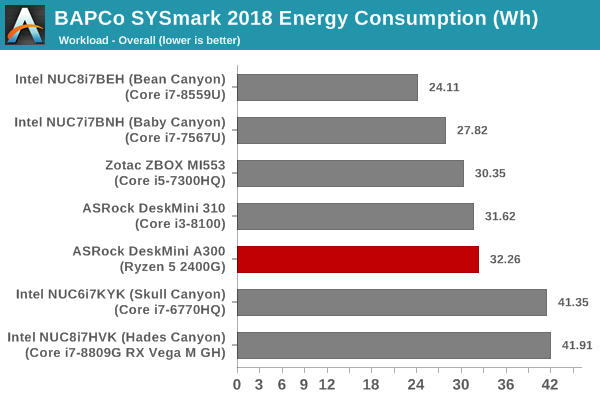
In the rest of the review, our focus will be on comparing the performance of the DeskMini A300 with the Ryzen 5 2400G and the DeskMini 310 with the Core i3-8100. Our builds for the system have approximately the same price point, and they are both contemporary systems. The overall energy consumption for the A300 is only slightly higher than the DeskMini 310, but the benchmark scores are lower. The DeskMini A300 configuration performs as well as the Zotac ZBOX MI553 (with the 45W Core i5-7300HQ) and the Baby Canyon NUC (with the 15W Core i7-7567U). However, those machines consume around 2 to 5 Wh less to achieve those scores.










88 Comments
View All Comments
abufrejoval - Friday, April 26, 2019 - link
Very nice review!But surprisingly little relative change (relative to publicity...) from the previous (major) iteration, which I interpret as the Kaveri vs. Skylake Iris Plus that I own and tested, A10-7850k vs. i5-6267U.
Intel still seems to never use more than 15Watts for the CPU, yet manages scaling single to 4GHz at great IPC while it manages to sustain admirable Hertz even at multi-core constant loads, taking a nice sip of cool on every little stall. AMD seems to retain a much more linear efficiency curve where clocks and cores just eat power, while the difference at the wall plug is much smaller in this iteration (was 3:1 for exactly the same performance on my old systems).
The good thing is that on a device like this, peak power is much less important than on a notebook, so it’s ok, as long as maintains quiet on constant peak and (finally) reaches acceptable idle: Here I see a lot of progress on AMD's side, Intel has much less room to beat itself.
For graphics, bandwidth is so crucial and I wonder what the AMD could do with a bit of eDRAM, HBM or even a lower-power variant of GDDR5… but I guess the latency issues could kill browser performance and that is unfortunately a large chunk of what buyers would want these for…
Still dreaming of a way to put well-proportioned APUs in a scalable system with 1x/2x/4x configs… With storage and RAM no longer eating box space, 75/150/300 Watt configs could be relatively small yet remain quiet.
Speaking of idle power and quiet, this is where I get interested in the AMD. The NUC is great in everything but noise on peak load, but it would really only take a replacement top and a Noctua to make it great… There is so much space behind these giant 4k screens, nuc/NUC can become a little pointless.
Good Linux support is where I am getting concerned. Current reports praise AMD on their Linux vision… but progress seems a very different story and one where Intel (sorry Charly), really shines, even Nvidia seems better in practical terms (sorry Linus). I’m also somewhat disheartened by power management there: Not sure I’ll be able to reach 10 Watt of idle on CentOS or Ubuntu *and* Steam/Vulkan performance comparable to Windows (it’s actually gotten quite good on bigger Nvidia GPUs, even GPU pass-through to a Windows VM is kind of fun).
sor - Saturday, April 27, 2019 - link
As I mentioned probably as you were typing this, I ran Ubuntu straight out of the box and am getting nearly 50% better FPS than this review on Dota 2. Full vulkan support and max settings. Pleasantly surprised, I am used to having to tinker with drivers.Notably, I don’t think this would have been possible 8 months ago as only newer kernels have the good AMD support built in.
Pishi86 - Saturday, April 27, 2019 - link
This is not exactly a fair comparison. You are comparing a desktop AMD chip with and a mobile Intel chip. Its kind of like comparing an i3 8100 vs a Ryzen 5 3500u. AMD's Ryzen 5 3550H and Ryzen 7 3750H would have been more competitive. These chips are about as fast as the 2400G, but with an maximum TDP of 35w. There are some reviews on Notebookcheck and these chips are consuming just over 70w underload. This is with a 15.6 1080P screen and a power hungry Radeon RX 560X. The power consumption and battery life is actually better than an i5 8300H and 1050 combo with an identical. Check out the review below.https://www.notebookcheck.net/Asus-TUF-FX505DY-Ryz...
The truth is the onboard Vega on Ryzen is a very powerful iGPU held back by memory bandwidth. Unrestrained, its probably 80-90% as powerful as an RX 460. It has 640-704 Vega cores which are clocked higher (1.2-1.4GHz) than the 896 cores in the RX 460. Vega's IPC should be a bit above Polaris's.
I agree with you Linux support is spotty, I am a Linux user myself and I am in the market for a new laptop, but I may have to buy Intel despite its weak iGPU. Unfortunately, you can't find anymore Iris powered laptops these days (outside the macbook pro). Also, even though its improved AMD's video decode/encode is not as efficient as Intel's. I am not even sure if Nvidia is as efficient as Intel in video playback. Having that said I would not trust Intel's UHD graphics powering a 4k monitor, which is what I am in the market for.
Pishi86 - Friday, April 26, 2019 - link
Does anyone know if you could get a 3rd party power supply that's more than 120w? I mean 150w might be good, if AMD releases 95W APUs in the future. A 120W PSU might limit CPUs abover 65W.Lucky Stripes 99 - Sunday, May 5, 2019 - link
Yes, there are third party power bricks available that can supply more current. Just keep in mind that the power regulators on the motherboard may not be rated for that higher current and that you could shorten its life or run into stability issues if you attempted to use a more power hungry processor (assuming if the BIOS would even make it past POST with an unsupported processor).Haawser - Saturday, April 27, 2019 - link
Good luck buying one...Only EU retailers I could find seem to have sold out within hours. Still, will keep trying. As this is exactly the sort of SFF I've wanted since Ryzen APUs came out.ganeshts - Saturday, April 27, 2019 - link
On Amazon and Newegg, Computer Upgrade King seems to have lot of ready-to-go models with the DeskMini A300 ; Eg: https://www.newegg.com/Product/Product.aspx?Item=9... (Just FYI - I have no idea about the reputation of this retailer. Just came up during my search on Google)Haawser - Saturday, April 27, 2019 - link
@ganeshts- Again, out of stock. Personally I think ASRock, Lenovo, HP, Zotac and everybody else that manufacturers SFF PCs have greatly underestimated the number of people looking to buy Ryzen APU based systems. And with the improved 3000 series (12nm Zen+ with soldered HS) soon available, the barebones will be even more sought after.ganeshts - Sunday, April 28, 2019 - link
Shows in-stock for me when I added to cart : https://i.imgur.com/YWbYlJ6.pngoliwek - Saturday, April 27, 2019 - link
For people in NL or BE, I bought mine from here, delivered promptly : https://www.megekko.nl/product/2321/237330/Barebon...